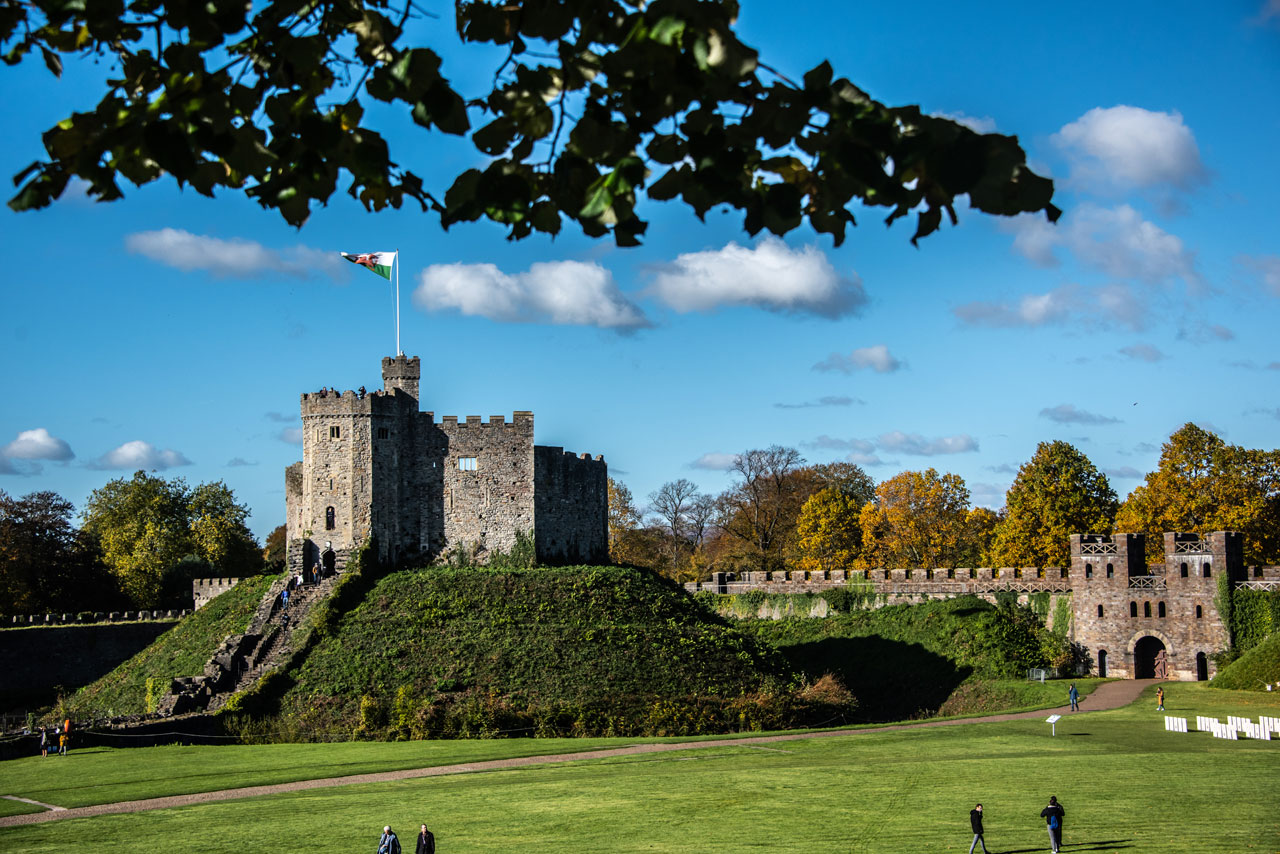- Home
- Welsh Castles
- Cardiff Castle
VISIT CARDIFF CASTLE

A brief history
Cardiff Castle, in the heart of the capital of Wales, is at once a Roman fort, a Norman stronghold and a Victorian Gothic Fantasy Palace.
Originally a Roman fort, the Normans realized the strategic value of the site and a new castle was raised by Robert Fitzhamon, Norman Lord of Gloucester. He erected a wooden keep on the earlier motte but his son-in-law, Robert, Earl of Gloucester, replaced the wooden structure.
The Welsh leader Ivor Bach captured the Norman stronghold in 1158. The buildings that remain today on top of the motte are thirteenth century and were erected by Gilbert de Clare. He put a wall across to the main gate house, thus creating two baileys. Further building took place in Tudor times along the west wall and the outer curtain was built up to the probable Roman height.
Cardiff Castle passed through the hands of many noble families. When the last of the de Clares was killed at Bannockburn the castle was acquired by the Despencers, favourites of Edward II and later by the Earls of Warwick.
In the 19th century architect William Burges created a massive Victorian addition for the 3rd Marquess of Bute. William Burges built the tall clock tower, the guest tower and the octagonal tower spire and completely redesigned the interior in the current medieval romantic style rich with gilding, elaborate wood carving, murals and stained glass.
In 1947 John Crichton-Stuart, the 5th Marquess of Bute, handed over the keys of Cardiff Castle to the Lord Mayor of Cardiff. In a philanthropic gesture the castle and the surrounding parkland was presented to the People of Cardiff.
castle Attractions
THE NORMAN KEEP
The twelve-sided Keep is known as a shell keep because its outer walls provided a shell for smaller buildings inside. To reach the viewing platform you have to climb 50 steep stones to reach the entrance to the Keep and then some more. The panoramic views from the viewing platform are stunning and on a good day you can see as far as castle Coch.
THE CASTLE APPARTMENTS
From the 1500s, as times became less turbulent and defence was less of a priority, it became important to make Cardiff Castle more comfortable to live in. The Earls of Pembroke set about to create a luxurious home here.
By the time the Bute family inherited Cardiff Castle in 1766 it had fallen into a state of disrepair. Lord Bute employed the architect Henry Holland and Capability Brown, his father in law, to undertake an ambitious programme of demolition and rebuilding.
In 1865 the 3rd Marquess of Bute commissioned architect William Burges to transform Cardiff Castle into an opulent palace and gothic feudal extravaganza.
Make sure you visit Lord Bute's Study, the Arab Room, the Banqueting Hall, the Small Dining Room, the Drawing Room and the Library.
THE TREBUCHET
The Trebuchet at Cardiff Castle is an accurate replica of a 13th century siege engine developed to attack the solid walls of castles. Large rocks and stones were placed in the catapult sling and hurled towards a castle with such force that they could easily break through a castle wall.
The Trebuchet at Cardiff Castle sits proudly on the Castle Green and was originally built by local professional carpenters for the Hollywood Movie Ironclad.
FIRING LINE - CARDIFF MUSEUM OF THE WELSH SOLDIER
This museum is situated in the grounds of Cardiff Castle and is a museum that celebrates the Welsh soldier over a period of 300 years. The museum stands as a testament to the extraordinary contributions made by ordinary Welshmen to their Regiments, History and to Wales.
THE ROMAN WALLS
In 1888, when the 3rd Marquess of Bute decided to built a new tower, his workmen discovered the remains of a Roman Fort. Archaeological excavations showed that this was the first of four forts, each a different size, that occupied the present site.
WARTIME SHELTERS
Within the walls of Cardiff are tunnels which were used as air-raid shelters during the last war. The shelters are now open to the public and for guided tours. When the sirens sounded, people who lived and worked in the City would rush to the shelters which could take more than 1800 people. There were dormitories with bunk beds, kitchens, toilets and first aid posts concealed within the walls.
THE BATTLEMENT WALK
Today you can walk along three sides of the Castle's outer defences. All three sections of wall starting from the south wall, around the east and ending at the north gate are actually Victorian reconstructions of a Roman Fort that once occupied the fort.
In 1888 Lord Bute's workmen started to clear away Norman earthworks in order to build a new tower. The excavations revealed remnants of a Roman Wall and the 3rd Marquess decided to rebuild the fort on top of the Roman foundations which was completed by the 4th Marquess in 1923.
Location
Cardiff Castle
Castle Street, Cardiff CF10 3RB
Official website: Cardiff Castle
By Car
Via M4, exit at junction 32 and follow the A470 to Cardiff City Centre
By Train
Cardiff Central and Cardiff Queen Street Stations are within easy walking distance of the Castle.
Great Western Railway operate trains from London Paddington and Swansea.
By Air
Cardiff Airport is around 15 miles from Cardiff Castle and offers regular bus and rail links.

